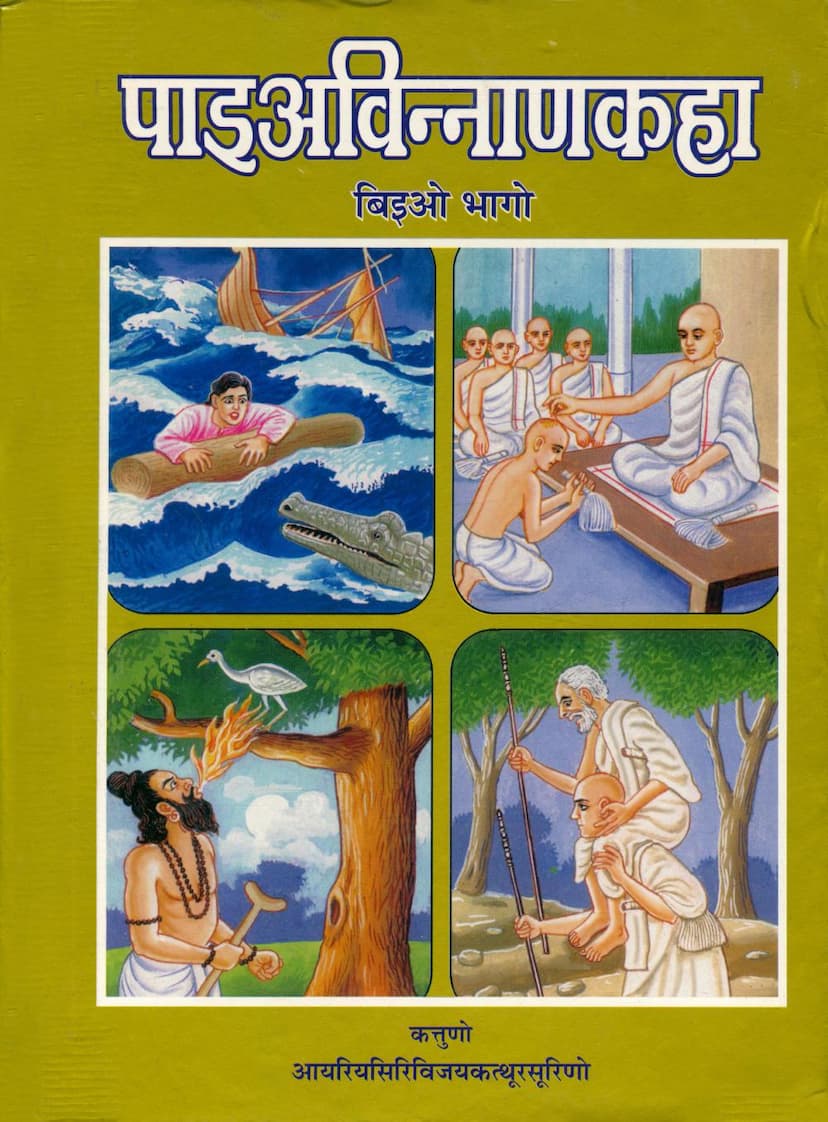Paiavinnankaha Part 02
Added to library: September 2, 2025

Summary
This is a comprehensive summary of the Jain text "Paiavinnankaha Part 02," authored by Kastursuri and Somchandrasuri, published by Rander Road Jain Sangh. The text is a collection of Prakrit tales (Katha) aimed at imparting moral and spiritual lessons.
Key Themes and Content:
- The Power of Stories (Katha): The text emphasizes the importance of stories in Dharma Shastras for explaining and reinforcing teachings. Stories are presented as enjoyable for all ages and capable of bringing peace to the mind. History itself is seen as being shaped by stories of heroes.
- Jain Agama and Kathānuvoga: Jainism, like other philosophies, utilizes stories (Kathānuvoga) within its scriptures (Āgamas) to illustrate concepts. The text highlights the four branches of Anu-yoga in Jainism: Dravya, Ganita, Charana-Karana, and Kathā. It mentions the vastness of stories within Jain literature, referencing examples like the Gnata-dharma-kathānga-sutra, Upāsaka-dashānga-sutra, and Rājapraśnīya-sutra.
- Revival of Prakrit Literature: The book is a significant contribution to the revival of Prakrit literature, particularly Jain Prakrit narrative literature. It acknowledges the efforts of Acharya Shri Vijay Kastūr-sūriśvarji Mahārāj in this endeavor, noting that new Prakrit narrative literature had been scarce in the 20th century.
- Life of Acharya Shri Vijay Kastūr-sūriśvarji: A significant portion of the text is dedicated to the biography of Acharya Shri Vijay Kastūr-sūriśvarji Mahārāj. It details his birth, education, initiation into monkhood, and his various religious titles and achievements, including becoming a Pravartak, Ganī, Upādhyāya, and finally a Sūri. His dedication to the propagation and revitalization of Prakrit language is a central theme.
- Literary Works of Acharya Shri Vijay Kastūr-sūriśvarji: The text lists numerous works authored or published by Acharya Shri Vijay Kastūr-sūriśvarji, focusing on Prakrit language and literature. These include "Prākṛta-rūpamālā," "Prākṛta-vijñāna-pāṭhamālā," "Prākṛta-gadya-padya-mālā," and various compilations of stories and character sketches.
- The Narrative Style: The tales within "Paiavinnankaha" are characterized by their simplicity, clarity, and engaging style, making them accessible and enjoyable for a wide audience. The stories are designed to be relatable and easy to understand, often incorporating moral conclusions and practical advice.
- Content of the Tales: The book contains a collection of 56 to 108 (and possibly beyond, based on the indexing) individual stories. Each story is numbered and often begins with a Prakrit stanza summarizing its theme or moral. The tales illustrate various aspects of Jain philosophy, ethics, and conduct, often through the lives of kings, merchants, ascetics, and lay followers. The stories cover themes such as:
- Karma and its consequences: Many tales highlight how actions in this life, both good and bad, lead to specific outcomes in this or future lives.
- Right Conduct and Faith: The importance of righteous living, adherence to vows, and maintaining right faith (Samyaktva) are frequently depicted.
- Virtues and Vices: Stories contrast virtues like generosity, compassion, patience, and devotion with vices like greed, anger, pride, and deception.
- The power of devotion and penance: Several narratives showcase how sincere devotion to Jain principles and rigorous penance can lead to spiritual progress, even liberation.
- The efficacy of good company: The text implies the importance of associating with virtuous individuals and avoiding negative influences.
- The transient nature of worldly pleasures: Many stories illustrate the impermanence of material possessions and worldly attachments, encouraging detachment.
- Specific Story Examples (as seen in the table of contents): The summary includes a glimpse into the variety of stories, with titles suggesting themes like:
- "Anandāva-sagassa" (Story of lay disciple Ānanda)
- "Vayavirāhaṇāe Nandamaṇiyārasetthiṇo" (Story about Nandamaṇiyāra-śreṣṭhī's violation of vows)
- "Mahāpuruṣadarśane Raṇṇundurassa" (Story about seeing a great soul - Raṇṇundra)
- "Karma-pariṇāmo naṇaḥā ho'i" (The result of karma is not altered)
- "Sohaṇakajje bhāyara-tigassa" (The story of three brothers in good deeds)
- "Ātho aṇāthakāro" (Wealth is the cause of ruin)
- "Sāmaiya-mmi Vuḍḍhāe" (Story of an old woman practicing Sāmayika)
- "Tava-pabhāvo-varimā Rāyakannā Visallāe" (The glory of penance, story of princess Visallā)
- "Paravañcaṇammi vaṇiyassa" (Story of a deceitful merchant)
- "Mahāpuruṣaviṣayāi-vaṇeho bhavatāro ho'i" (Attachment to great souls brings salvation)
- "Arati-cāritra-mohu-u-dayammi Khullagakumāra-samaṇassa" (Story of the young monk Khullaka experiencing delusion in attachment to aversion)
- "Sammatti-viśuddhiye Candalehāye" (Story of Candralēkhā's purity of right faith)
- Editorial and Publishing Details: The book is presented as a second edition, with details of the publisher (Shri Rander Road Shvet. Ma. Pa. Jain Sangh, Adajan Patiya, Surat) and contributing individuals and institutions, including the editors and typists. It also mentions the printing press and the year of publication (Vikram Samvat 2061 / 2005 CE).
Overall Significance:
"Paiavinnankaha Part 02" is a valuable resource for understanding Jain narrative traditions, Prakrit language, and the moral and ethical teachings central to Jainism. It serves as an educational tool for students and scholars interested in Jain literature and philosophy, highlighting the enduring relevance of ancient stories for contemporary life. The dedication of the book to Acharya Shri Vijay Kastūr-sūriśvarji Mahārāj underscores his pivotal role in preserving and promoting this rich literary heritage.